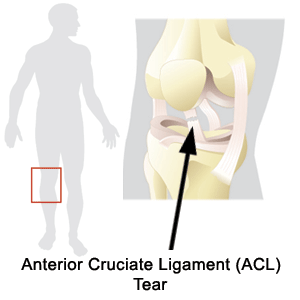Medical Library
Loading...Please Wait
Select an Article:
- Quadriceps Muscle Strains
- Meniscal Tears
- Anterior Cruciate Ligament (ACL) Tear
- Posterior Cruciate Ligament (PCL) Tear
- Medial Collateral Ligament (MCL) Tear
- Lateral Collateral Ligament (LCL) Tears
- Anterior Knee Pain
- Patello-femoral Pain (Commonly Called Chondromalacia Patella)
- Patellar Tendinitis (Jumper's Knee)
- Knee Osteoarthritis
- Iliotibial Band Friction Syndrome (ITBS)
- Knee Replacement
Anterior Cruciate Ligament (ACL) Tear

The cruciate (or crossing) ligament stabilizes the knee. The anterior cruciate (ACL) may completely break (rupture) when the knee is bent beyond its normal range of motion or with excessive twisting. Signs and symptoms include a ‘pop’ sensation with significant swelling and pain. There is a sense of instability or the knee giving away. Initial treatment includes rest, ice, elevation, and compression. Physical therapy consisting of progressive strengthening and functional exercise may facilitate recovery. If knee instability persists, surgery is indicated. The middle third of the patellar tendon, hamstrings, or cadaver ligament may be used to reconstruct the lost ligament.
ACL tears are common in teenage female athletes. Some of the best clinical/sports medicine research to date, suggests that a preventive training program can significantly reduce the risk of ACL injuries in female adolescent athletes.
Possible Treatments
- Aerobic/Endurance Exercise

- Core Strengthening

- Cryotherapy or Cold Therapy

- Electrotherapeutic Modalities
- Gait or Walking Training

- Isometric Exercise

- Knee Active Range of Motion

- Knee Passive Range of Motion

- Neuromuscular Electrical Stimulation

- Proprioception Exercises

- Physical Agents
- Soft Tissue Mobilization

- Stretching/Flexibility Exercise

Possible Treatment Goals
- Improve ability to bear weight/stand on the leg(s)
- Decrease Risk of Reoccurrence
- Improve Fitness
- Improve Function
- Improve Muscle Strength and Power
- Increase Oxygen to Tissues
- Improve Proprioception
- Decrease Postoperative Complications
- Improve Range of Motion
- Self-care of Symptoms
- Improve Safety
- Improve Tolerance for Prolonged Activities
- Improve Wound Healing
Additional Resources
Disclaimer
The information within this Medical Library does not represent the views, opinions, advice, or treatment philosophy of E6 Physical Therapy. Any reference herein to any specific commercial product, process, or service by trade name, trademark, manufacturer, or otherwise, does not constitute or imply its endorsement, recommendation, or favoring by E6 Physical Therapy or its employees/affiliates and any such reference shall not be construed as advertising or product endorsement.